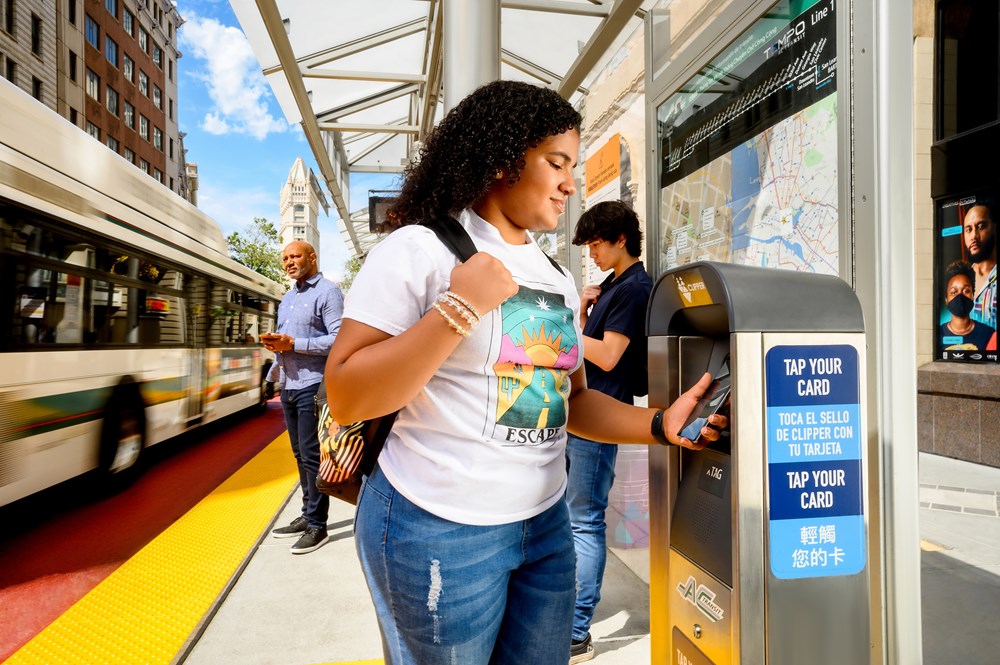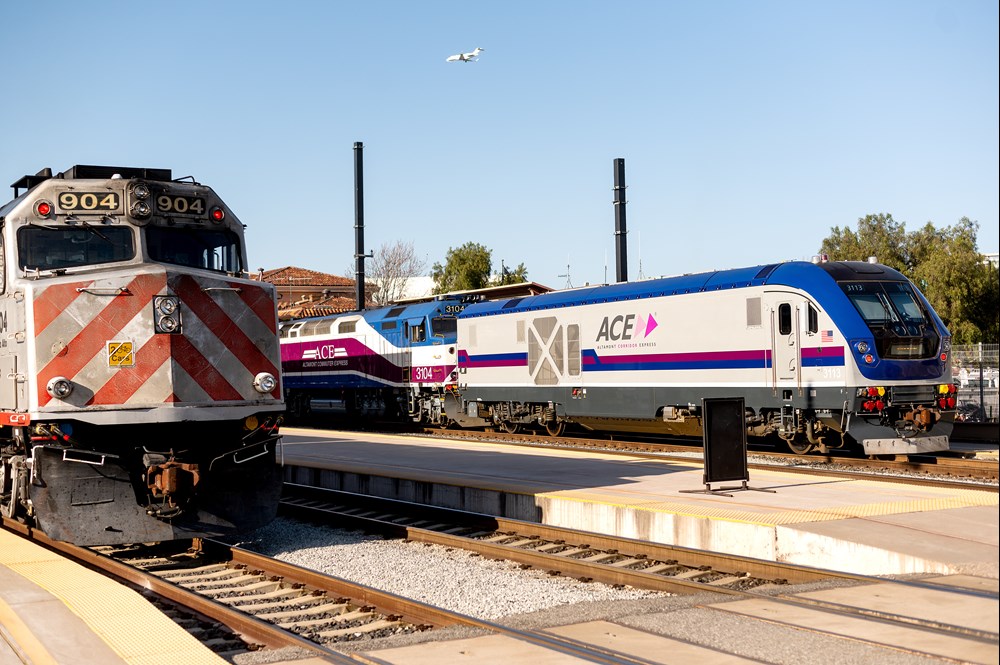Coordinating for You
Bay Area transit’s transformation into a more connected, more efficient and more customer-focused mobility network continues to move forward, due in large part to the strong collaboration among MTC and the Bay Area’s transit agencies.
Using the Bay Area Transit Transformation Action Plan as its roadmap, MTC and the transit agencies have focused on five areas—fares and payments, customer information, transit network, accessibility, and funding—to reshape the Bay Area’s transit network and improve it for existing and future riders.
Despite the ongoing challenges of the COVID-19 pandemic and transit funding shortages, we have made progress on several initiatives. Below is an update on some of the work we have done, as of January 2024.
Fares & Payment
Clipper® BayPass Pilot Program
Fare coordination and integration is a cornerstone of the Bay Area Transit Transformation Action Plan. MTC teamed with BART and other transit agencies to launch Phase I of the Clipper BayPass pilot in August 2022. The purpose of the program is to study the impact of a single pass that can be used for unlimited access to all Bay Area bus, rail and ferry services, except for San Francisco’s Muni cable cars. To date, Clipper BayPass has been made available to 50,000 people, including residents of several affordable housing complexes managed by MidPen Housing, students at Santa Rosa Junior College and randomly selected students at San Francisco State University, San Jose State University and the University of California’s Berkeley campus.
Clipper BayPass participants used their passes for more than a combined 2 million transit trips in the first year of the pilot. Usage data indicate these customers take some 40% more transit trips than their nonparticipating peers and transfer between systems 74% more often.
In January 2024, Phase II of the pilot launched with the addition of three employers—UCSF, the City of Menlo Park and the Alameda Transportation Management Association—to the program. The Clipper BayPass will be made available to as many as 20,000 individuals at up to 10 different companies, institutions or public agencies during the pilot program’s second phase.
The Survive & Thrive roadmap released in 2023 by MTC, transit agencies, and business and policy advocacy groups identifies Clipper BayPass as a key strategy for retaining and growing ridership.
Clipper® START pilot program
The Clipper® START pilot program provides a 50% transit-fare discount for lower-income adults ages 19 to 64 for rides on all systems that accept Clipper for fare payment.
Clipper START began as an 18-month pilot program initiated in June 2020 by MTC and four transit agencies to reduce the cost of transportation for adults whose household incomes are no more than twice the federal poverty level (currently $60,000 for a family of four). Since then, the 19 additional transit agencies have joined the pilot program, and the pilot’s end date has been extended twice to June 30, 2025.
Previously the transit agencies varied in which ones offered discount programs and by how much. With Clipper START, eligible riders can receive a uniform discount, no matter which transit system they use.
No cost/low-cost transfers
Transit agencies later in 2024 will expand fare integration with the launch of a pilot program for no-cost and reduced-cost transfers for rides between agencies.
Learn more about fare integration and coordination projects.
Customer Information
Mapping & Wayfinding
In January 2024, transit agency and MTC staff unveiled design prototypes for a common set of signs to be used by all agencies at all locations — from individual bus stops to major hubs where multiple systems connect. These prototypes will be installed later this year at the El Cerrito del Norte BART station, the Santa Rosa Transit Mall and the nearby Santa Rosa SMART station, where riders will be asked to give their input on the prototypes.
To establish and reinforce a common identity for all Bay Area transit services, the new signage employs a three-color palette of golden yellow, sky blue and dark blue; as well as simple icons to identify service by trains, buses or ferries. These icons are larger and more visually prominent than the logos of the individual agencies providing the services at each location. The modal icons and the three-color palette will be extended to a new mobile-friendly website to which passengers can connect via QR codes at each bus stop, train station or ferry terminal, providing real-time information along with accessibility features such as audio descriptions and language translation.
Accessibility and equity are important aims of the regional mapping and wayfinding work. Key to the process is getting input from people with disabilities, who rely heavily on public transit to get around the Bay Area.
The new wayfinding system will include high contrast between text and background for better visibility, information at an accessible height, Braille and tactile bus service information, and simplified instructions for using the Clipper electronic transit-fare payment system. Track our efforts on improving wayfinding.
Transit Network
Schedule Alignment
The Bay Area’s transit agencies are coordinating for better near-term service and schedule planning. We’re aligning our schedules so it’s easier for riders to make connections between transit agencies. For example, we are sharing schedule changes with each other earlier and developing data tools to enable better coordination of connections. This means fewer near misses and less waiting time.
Transit Priority
We’ve made major strides giving buses priority on our roadways. The SFMTA added 15 miles of transit lanes during the pandemic, and those lanes have made it possible for Muni buses that drive on those roads to be 15 – 20% faster. Golden Gate Transit also has access to SFMTA’s Van Ness Ave. lanes. The SFMTA and Caltrans partnered to launch the first urban high-occupancy vehicle (HOV) lanes in California.
In Dec. 2023, MTC sponsored a workshop with attendees from county transportation agencies, cities, transit advocacy organizations, Caltrans, and transit agencies to kick off the development of a regional Transit Priority Policy, which aims to establish a vision to support the implementation of transit priority initiatives throughout the Bay Area. The next steps include forming an ad-hoc policy development working group and developing policy text.
Transit Network Planning
MTC is working closely with the region’s transit agencies on Transit 2050+ — a long-range planning effort that will develop a first-of-its-kind plan to re-envision the future of the public transit network in the nine-county Bay Area. Transit 2050+ aims to lay the foundation for a service-oriented, fiscally constrained transit network plan for the Bay Area. Learn more about Transit 2050+.
Regional Network Management
Regional Network Management (RNM) looks at the entire transit system to identify ways to improve the network and rider experience.
Three meeting bodies—RNM Committee, RNM Customer Advisory Group and RNM Council—are guiding the Regional Network Management work at MTC. Together, these committees provide input and make recommendations based on the expertise of transit leaders and Bay Area transit riders.
Funding
MTC and Bay Area transit agencies helped secure funds in the fiscal 2023-24 state budget to give Bay Area transit a near-term lifeline to help support their operations. The state investment is helping transit agencies avoid a near-term ‘fiscal cliff’ that likely would have led to deep service cuts by Muni, BART and other agencies whose fare revenues remain well below pre-pandemic levels.
The state budget offers an important but temporary fix for Bay Area transit agencies. Even with this new state funding, some agencies are facing budget deficits in the tens of millions of dollars in 2024, growing to hundreds of millions the year after.
State budget funds will assist the Bay Area’s transit agencies as they recover from the pandemic and develop long-range funding plans, such as a future regional transportation funding measure for voter approval that will support the region’s transit network. In January 2024, after spending much of 2023 engaging with the public and partners, MTC voted to seek enabling legislation in 2024 to put a regional transportation measure on the 2026 ballot.




